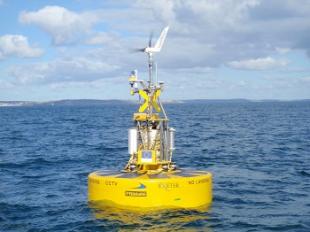Dynamic Marine Component Test Facility
The Dynamic Marine Component Test Facility (DMaC) is a purpose built test rig that aims to replicate the forces and motions that components are subjected to in offshore applications.
The test rig comprises of a linear hydraulic cylinder that can be used to replicate any pulling (tension) and pushing (compression) force representative of dynamic loadings, pre-loadings, etc. (termed the Z actuator in the tailstock position). At the other end of the rig the moving headstock with three degrees of freedom (namely pitch, roll and yaw) representative of x- and y-bending or torsion allows to replicate the movement and forces (e.g. bending moments) induced through the motion of a floating body. The working principle is schematically illustrated in the Figure below.
The rig is capable to replicate tensile forces of up to 30 tonnes in dynamic and 45 tonnes in static operation. The maximum bending angle at the headstock is ±30º for x- and y-bending. The rig can test specimens up to a length of 6 meters. Beyond that, the rig has the unique feature that components can be immersed in fresh water to allow the testing in a wet environment. These features allow a dynamic testing of components in large scale under controlled environment applying realistic motion characteristics.
South West Mooring Test Facility
The intention for the research facility is to identify uncertainties for moored offshore renewable energy systems that will respond in a coupled fashion. Instead of using tank tests, prototype installations and numerical analysis to support the design of a WEC, the data gathered from the test facility will be used to calibrate numerical models, enhance the physical understanding of the coupled behaviour and obtain understanding of component loading and deterioration.
The South West Mooring Test Facility is located in Falmouth Bay, Cornwall, UK, near the Manacles rocks, just south of the mouth of the Helford River. The buoy is fully equipped with load cells, motion sensors and other instrumentation to test a variety of catenary and taut mooring arrangements. It transmits data directly to the shore and allows comprehensive evaluation of mooring systems under real sea conditions. Installation and survey support is also provided. The objective of the mooring test facility is to allow device developers to test mooring and anchor designs or specific components, cost effectively, in a realistic offshore environment. Such testing is invaluable for validating design methods and computer-based numerical models and obtaining reliability data. These services are provided through experience researchers with long track record and internal and external technical support.








